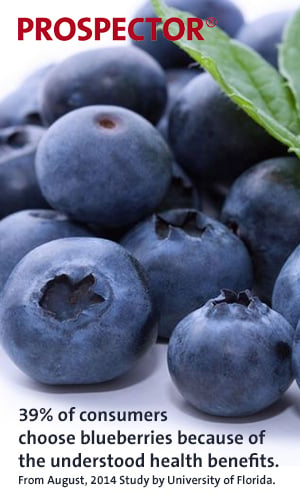 With popularity expanding worldwide, blueberries are a tiny, nutrient-packed fruit often considered a superfood.
With popularity expanding worldwide, blueberries are a tiny, nutrient-packed fruit often considered a superfood.
Blueberries (EU) are native to America, but are now grown in Europe, Asia and Australia. The US Highbush Blueberry Council reported that while the US consumes roughly 2.2 lbs of blueberries per person annually, exports are growing. In 2013, over 3000 new blueberry products launched in Asia, Europe and Latin America, while 1000 new products launched in North America.
Blueberries fall into three main categories; Highbush (Vaccinium corymbosum), Lowbush (Vaccinium angustifolium), and Rabbiteye (Vaccinium ashei). Highbush blueberries are the main cultivated species and produce large berries. Usually frozen after harvest, Lowbush blueberries, or “wild”, are small with intense flavor and color. Rabbiteye blueberries are cultivated varieties grown in the south. With the variety of species and harvest locations, blueberries are available all year.
Superfood Status:
Studies indicate blueberries improve many aspects of health. While research is still ongoing, blueberries have been shown to improve memory and cognitive function, prevent or inhibit cancer growth (including breast and prostate cancer), improve heart health, lower the risk of type 2 diabetes and increase blood sugar regulation, improve digestion, and fight eye disease.
Nutrition Facts:
- 80 calories per cup
- Low in Fat
- Vitamin C and A
- Manganese
- Dietary Fiber
- High level of Antioxidants (phenol and anthocyanin)
Health is important, but Flavor is Key:
A recent study released in August 2014 from the University of Florida showed that 61% of blueberry consumers are purchasing blueberries for their flavor only. The other 39% are choosing blueberries because of the understood health benefits. As the link to health is strengthened with continued research and a preferred flavor profile, blueberry consumption is expected to grow in both the US and worldwide.
The US Highbush Blueberry Council identifies the potential for natural vs. artificial blueberry ingredients, indicating that consumers are likely to pay more for products made with real blueberries.
Innovation: Sweet to Savory and beyond the berry:
The sweet flavor lends blueberry to sweet applications including foods eaten in the morning, snacks enjoyed all day long, or dessert applications. Blueberry performs well in muffins (EU) and quick bread, in beverages like smoothies (EU) or juices, in dairy products like yogurt or yogurt drinks and soft cheeses, and as ice cream toppings or inclusions. Blueberry blends perfectly with ginger, cinnamon, cardamom, nutmeg and vanilla profiles.
However, as a cousin to cranberry, expanding blueberry into mainstream savory applications is an innovation opportunity. Historically Native Americans used blueberries as a meat rub, or in soups. The Oregon Blueberry Commission recently awarded first place to a recipe for blueberry paired with salmon. Blueberries could transform condiments with offerings like blueberry ketchup, blueberry salsa, or blueberry vinaigrette. Or, developers can create meal solutions like a high end frozen pizza topped with blueberries, gorgonzola, pancetta and red onion. In savory dishes blueberry is complemented by basil, cilantro, mint and black pepper.
Finally, blueberry leaves also contain antioxidants and blueberry leaf extracts are available. Alternatively, with tea a top trend for 2014, blueberry tea (EU) may be a unique ingredient to include in formulations. Tea made from blueberry leaves has shown health benefits in blood sugar regulation.
Formulation Thoughts:
Blueberries are available in a multitude of forms; fresh, frozen, canned, dehydrated, freeze dried, powdered, pureed and as juice or concentrate. To extend the blueberry presence when under a strict formula budget, blueberry flavors (EU) and specialty ingredients, like cranberries (EU), infused to look and taste like blueberries, are good ingredients to explore.
Anthocyanins, which provide the deep blue color and high level of antioxidants, are changed by processing. Research out of South Dakota State University in June 2014 indicates that freezing blueberries increases the availability of anthocyanin in blueberries. Alternatively, anthocyanin readily breaks down, affecting color and antioxidant function, during thermal processing.
Blueberries are acidic with a pH of around 3. When formulating with blueberries, be conscious of the final product’s pH to maintain anthocyanin function. For example, using baking soda in baked goods can swing the pH basic, which will result in a green color instead of the hallmark blueberry color. To counter this effect, you can use an additional acid in the formula and blend the leavening well into the dry components before adding the blueberries.
To get started experimenting with blueberries, here are some ingredients to review:
Product Resources North America:
Nibs Blueberry Medium – 49040 from in2food
Blueberry Sauce (19153) from Dutch Organic International Trade
Fruit Juice Concentrate, Blueberry (BLU05) from Tree Top Ingredients
Dried Wild Blueberries from Woodland Foods
Frozen IQF Blueberries from AgroCepia S.A.
Product Resources Europe:
Blueberry Sauce (19153) from Dutch Organic International Trade
IQF Blueberry, Cultivated from Agrana Group
BLUEBERRY, WILD from Freeze-Dry Foods
Blueberry Puree Concentrate (270628) Kosher from Northwest Naturals
Blueberry Juice Concentrate 65 Brix 55R65 from Berrico FoodCompany
The views, opinions and technical analyses presented here are those of the author or advertiser, and are not necessarily those of ULProspector.com or UL Solutions. The appearance of this content in the UL Prospector Knowledge Center does not constitute an endorsement by UL Solutions or its affiliates.
All content is subject to copyright and may not be reproduced without prior authorization from UL Solutions or the content author.
The content has been made available for informational and educational purposes only. While the editors of this site may verify the accuracy of its content from time to time, we assume no responsibility for errors made by the author, editorial staff or any other contributor.
UL Solutions does not make any representations or warranties with respect to the accuracy, applicability, fitness or completeness of the content. UL Solutions does not warrant the performance, effectiveness or applicability of sites listed or linked to in any content.


